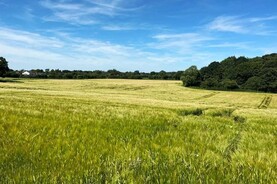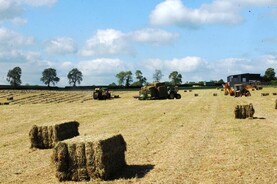Speaking as an independent observer of the current straw market (I am self-sufficient and neither buy nor sell), it was fascinating to watch the shifting sands of farmer emotion on display, as the days rolled by during the current harvest.
After the ravages of last year’s weather decimated leftover supplies at the back of sheds, there was something close to panic (anxiety certainly) in the body language of agricultural discussions.
With winter cereals generally performing well below par regarding straw yields and an unusually late planting season for spring crops, straw availability for the winter ahead was foremost in the thoughts of many livestock farmers.
Rumour mill
Before the bulk of the harvest really kicked off, the rumour mill centred not only around the widespread acceptance that 4 x 4 rounds would be £30, but would there be enough to go round? Then, as harvest progressed and barley yielded far better than anyone imagined, it became clear that even if straw was expensive, at least scarcity wasn’t as big an issue as first feared.
As a result, conversations that one month ago featured people discussing straw with a vaguely haunted expression on their faces, miraculously turned around into something entirely different. Suddenly these same people were exuding an air of cockiness when they proclaimed that there were “oceans of straw” pouring out of combines and “no way will it be £30”. We shall see.
My own guess is that the open market will hold at £30 collected in the field, with regular, good customers paying noticeably less.
Of course, when we say “good”, we mean those clients who come and clear a field without complaint or subsequent whingeing. For those eternal whiners, I sincerely hope the seller sticks both arms in as far as they will go. Some people do not appreciate that getting entire fields of straw into excellent condition can be quite a challenge.
Planted
My own barley was planted on 11 May. Field conditions had been far too raw until this date, and I had the familiar problem of balancing sowing date against declining yield potential. I accepted that 2t/acre was the most this worn field could possibly attain and was subsequently blown away when it weighed 2.7t/acre at 17% moisture.
Equally pleasing was a good crop of straw that baled into 7 really solid rounds per acre.
I’m not sure what set of meteorological conditions allowed late-sown cereals to perform like this (there are plenty of confirmed reports of barley easily exceeding 3t/acre in suitable land) but given the lack of sunshine throughout the summer, it is nothing short of a small miracle. In all honesty, I didn’t think it was possible for barley and oats to yield well with a mere four month growing window.
There was one very small hiccup for some growers. The glorious weather in mid-September maybe came a few days early for some fields that just needed another week to fully ripen the straw. This meant that although grain was maybe 18%, the straw needed a bit of time to “make” in the row.
Wuffler
My own straw got 5mm rain after cutting, so we let it lie over the weekend and extracted the mighty wuffler from the depths of the shed.
I was secretly delighted by this turn of events since this machine hasn’t turned a wheel in about four years and I’m always looking for an excuse to get using it.
Snoring up and down rows of straw and watching them fluffing up behind you is one of those endlessly satisfying farming operations.
Someone must have seen me driving down the road with the swath turner (official title) on behind because next thing I received a couple of phone calls, requiring my services. And there isn’t one farmer in the world who would phone up and ask for a ‘swath turner’. No, they know exactly what is needed for their fields – it’s a wuffler.






 This is a subscriber-only article
This is a subscriber-only article










SHARING OPTIONS: